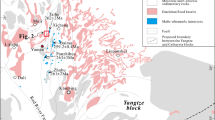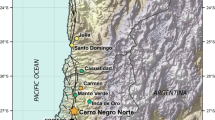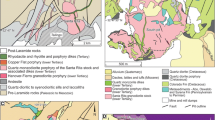Abstract
Textural and compositional data are presented for different types of magnetite in the Chadormalu iron deposit to discern the genesis of various styles of mineralization. Samples were chosen according to their paragenetic relations to apatite and their host setting: magnetite-apatite veins in the altered host rocks, disseminated magnetite-apatite assemblages in the marginal parts of the main ore body, and massive magnetite associated with irregular apatite veinlets from internal part of the main ore body. Scanning electron microscopy - back scatter electron (SEM-BSE) images reveal that there are three main generations of magnetite in each of the different magnetite-apatite assemblages. Primary magnetite (Mag1) features abundant porosity and a dark appearance. A second generation of magnetite (Mag2) replacing Mag1 shows a lighter appearance with both sharp and gradational contacts with the primary magnetite crystals. The two magnetite types are related to dissolution-precipitation processes due to changing physico-chemical parameters of the ore fluids. A third type of magnetite (Mag3) with a recrystallized appearance and foam-like triple junctions was mostly observed in magnetite-apatite veins in the main ore body and in veins hosted by altered rocks. Electron probe microanalyses (EPMA) were utilized to discriminate the various magnetite generations in the different magnetite-apatite assemblages. Applying published elemental discrimination diagrams shows that most primary magnetites fall into the hydrothermal- and Kiruna-type fields. Primary magnetite contains lower FeO (88.77–93.65 wt.%; average 91.5 wt.%), and higher SiO2 (0.21–2.26 wt.%; ave. 0.32 wt.%), Al2O3 (0.001–0.45 wt.%; ave. 0.053 wt.%), and CaO (0.002–0.48 wt.%; ave. 0.078 wt.%) contents, which might be related to magmatically derived fluids. Secondary magnetites have higher FeO (89.23–93.49 wt.%; ave. 92.11 wt.%), lower SiO2 (0.037–0.189 wt.%; ave. 0.072 wt.%), Al2O3 (0.004–0.072 wt.%; ave. 0.019 wt.%), and CaO (<0.034 wt.%; ave. 0.013 wt.%) possibly showing a lower contribution of magmatic fluids in the formation of Mag2. The magnetite Mag3 contains the highest FeO (91.25–93.8 wt.%; average 92.69 wt.%), low to moderate SiO2 (0.008–1.44 wt.%; ave. 0.13 wt.%), Al2O3 (<0.732 wt.%; ave. 0.059 wt.%), and CaO (<0.503 wt.%; ave. 0.072 wt.%), and appears to have formed by recrystallization of the previous two generations. The different major, minor, and trace element compositions of various magnetite generations might be due to an ore-forming fluid that was initially magmatic-hydrothermal and evolved to moderately brine-dominated meteoric fluids. The involvement of a basinal brine is supported by the occurrence of a late phase 34S-enriched pyrite in the Chadormalu deposit.














Similar content being viewed by others
References
Barnes SJ, Roeder PL (2001) The range of spinel compositions in terrestrial mafic and ultramafic rocks. J Petrol 42:2279–2302
Barton MD (2014) Iron oxide(−Cu-Au-REE-P-Ag-U-Co) systems. In: Holland H, Turekian K (eds) Geochemistry of mineral deposits. Treatise on Geochemistry, 2nd ed, vol 13. Elsevier, Maryland Heights, pp. 515–541
Bonyadi Z, Davidson GJ, Mehrabi B, Meffre S, Ghazban F (2011) Significance of apatite REE depletion and monazite inclusions in the brecciated Se-chahun iron oxide-apatite deposit, bafq district, Iran: insights from paragenesis and geochemistry. Chem Geol 281:253–269
Borg S, Liu W, Pearce M, Cleverley J, MacRae C (2014) Complex mineral zoning patterns caused by Ultra-local equilibrium at reaction interfaces. Geology 42:415–418
Borumandi H (1973) Petrograpische und Lagerst attenkundliche untersuchungen der Esfordi-formation zwischen Mishdovan und Kushk bei Yazd/Zentral Iran. Unpublished PhD Thesis, University of Aachen, Germany
Boucher SM, Hannington MD, Dube B (2010) Primary and secondary ore textures in the West Ansil volcanic-hosted massive-sulphide deposit, Noranda mining camp, Rouyn-Noranda, Quebec. Current Research 2010–10. Geol Surv Can
Ciobanu CL, Cook NJ (2004) Skarn textures and a case study: the ocna de fier-dognecea ore field, Banat, Romania. Ore Geol Rev 24:315–370
Daliran F (1990) The magnetite-apatite deposit of Mishdovan, East Central Iran. An alkali rhyolite hosted, "Kiruna type" occurrence in the Infracambrian Bafq metallotect. PhD Thesis, Heidelberger Geowissenschaftliche Abhandlungen, Germany
Daliran F (2002) Kiruna-type iron oxide-apatite ores and apatitites of the bafq district, Iran, with an emphasis on the REE geochemistry of their apatites: In porter TM (ed) hydrothermal iron oxide copper-gold and related deposits: A global perspective, vol 2. PGC Publishing, Linden Park, pp. 303–320
Daliran F, Stosch HG, Williams PJ, Jamali H, Dorri MB (2010) Early-Cambrian iron oxide-apatite-REE (U) deposits of the Bafq district, east-central Iran. Geol Assoc Canada Short Course Notes 20:147–159
Dare SA, Barnes SJ, Beaudoin G, Méric J, Boutroy E, Potvin-Doucet C (2014) Trace elements in magnetite as petrogenetic indicators. Mineral Deposita 49:785–796
Deo B, Dube RK, Chatterji S (1989) Formation of porous magnetite in the initial stage of solid state reduction of hematite by metallic iron. ISIJ Int 29:345–347
Dupuis C, Beaudoin G (2011) Discriminant diagrams for iron oxide trace element fingerprinting of mineral deposit types. Mineral Deposita 46:319–335
Förster H, Jafarzadeh A (1983) The chadormalu iron ore deposits magnetite filled pipes: geodynamic projection Iran. Final Report, GSI, pp. 501–509
Förster H, Jafarzadeh A (1984) The chadormalu iron ore deposit (bafq district, Central Iran), magnetite filled pipes. Neues Jahrb Geol P-A 168:524–534
Förster H, Jafarzadeh A (1994) The bafq mining district in Central Iran: A highly mineralized infracambrian volcanic field. Econ Geol 89:1667–1721
Haghipour A (1977) Geological Map of Biabanak–Bafq Area.1:500,000, Geol. Surv. Iran
Hahn G, Pflug HD (1980) Ein neuer medusen-fund aus dem jungprakambrium von zentral-Iran. Senck Leth 60:449–461
Heidarian H (2013) Investigation of genetic relations between mineralization, host rocks and metasomatic alterations in chadormalu iron deposit, Central Iran. Unpublished MSc Thesis, Shahid Beheshti University, Iran (in Persian with English abstract)
Heidarian H, Padyar F, Alirezaei S (2012) Fluid inclusion evidence for a hydrothermal origin for magnetite-apatite ores at Chadormalu iron deposit, Bafq District, Central Iran. ACROFI-IV:32–34
Heidarian H, Alirezaei S, Lentz D (in review) Chadormalu Kiruna-type magnetite-apatite deposit, Bafq district, Iran: Insights from hydrothermal alteration evidence, geochemical, fluid inclusion, and sulfur isotopic data. Ore Geol Rev
Hemley JJ, Hunt JP (1992) Hydrothermal ore-forming processes in the light of studies in rock-buffered systems; II, some general geologic applications. Econ Geol 87:23–43
Hu H, Li J, Lentz D, Ren Z, Zhao X, Deng X, Hall D (2014) Dissolution-reprecipitation process of magnetite from the chengchao iron deposit: insights into ore genesis and implication for in situ chemical analysis of magnetite. Ore Geol Rev 57:393–405
Hu H, Lentz D, Li JW, McCarron T, Zhao XF, Hall D (2015) Reequilibration processes in magnetite from iron skarn deposits. Econ Geol 110:1–8
Huberty JM, Konishi H, Heck PR, Fournelle JH, Valley JW, Xu H (2012) Silician magnetite from the dales gorge member of the Brockman Iron Formation, Hamersley Group, Western Australia. Am Mineral 97:26–37
Jami M (2005) Geology, geochemistry and evolution of the Esfordi Phosphate–Iron Deposit, Bafq Area, Central Iran. Unpublished PhD Thesis, University of New South Wales, Australia
Jami M, Dunlop AC, Cohen DR (2007) Fluid inclusion and stable isotope study of esfordi apatite-magnetite deposit, Central Iran. Econ Geol 102:1111–1125
Jonas L, John T, Putnis A (2013) Influence of temperature and Cl on the hydrothermal replacement of calcite by apatite and the development of porous microstructures. Am Mineral 98:1516–1525
Knipping JL, Bilenker LD, Simon AC, Reich M, Barra F, Deditius AP, Lundstorm C, Bindeman I, Munizaga R (2015) Giant Kiruna-type deposits form by efficient flotation of magmatic magnetite suspensions. Geology 43:591–594
Larson JE (1983) Geology, geochemistry and wall-rock alteration at the magusi and new insco massive sulfide deposits, hebecourt township, Northwestern Quebec. Unpublished MSc Thesis, University of Western Ontario, Canada
Liang HY, Sun W, Su WC, Zartman RE (2009) Porphyry copper–gold mineralization at yulong, China, promoted by decreasing redox potential during magnetite alteration. Econ Geol 104:587–596
Lohberg BEH, Horndhal AK (1983) Ferride geochemistry of Swedish Precambrian iron ores. Mineral Deposita 48:487–504
Makvandi S, Beaudoin G, McClenaghan BM, Layton-Matthews D (2015) The surface texture and morphology of magnetite from the izok Lake volcanogenic massive sulfide deposit and local glacial sediments, Nunavut, Canada: Application to mineral exploration. J Geochem Explor 150:84–103
Mohseni S, Aftabi A (2015) Structural, textural, geochemical and isotopic signatures of synglaciogenic neoproterozoic banded iron formations (BIFs) at bafq mining district (BMD), Central Iran: the possible ediacaran missing link of BIFs in tethyan metallogeny. Ore Geol Rev 71:215–236
Moore F, Modabberi S (2003) Origin of choghart iron oxide deposit, Bafq District, Central Iran: new isotopic and geochemical evidence. J Sci Islamic Republic of Iran 14:259–269
Mousavi Nasab Z (1994) Geology and genesis of Choghart deposit, Bafq area, Central Iran. Unpublished PhD Thesis, Shiraz University, Iran (in Persian with English abstract)
Mücke A (2003) Magnetite, ilmenite, and ulvite in rocks and ore deposits: petrography, microprobe analyses and genetic implications. Miner Petrol 77:215–234
Mücke A, Cabral AR (2005) Redox and nonredox reactions of magnetite and hematite in rocks. Chem Erde-Geochem 65:271–278
Mücke A, Younessi R (1994) Magnetite–apatite deposits, Kiruna-type, along the sanandaj-sirjan and in the bafq area, Iran, associated with ultramafic and calc alkaline rocks and carbonatites. Miner Petrol 50:219–244
Müller B, Axelsson MD, Ohlander B (2003) Trace elements in magnetite from Kiruna, Northern Sweden, as determined by LA-ICP-MS. J Geol Soc Sweden 125:1–5
Nadoll P, Mauk JL, Hayes TS, Koenig AE, Box SE (2012) Geochemistry of magnetite from hydrothermal ore deposits and host rocks of the Mesoproterozoic Belt supergroup, United States. Econ Geol 107:1275–1292
Nadoll P, Angerer T, Mauk JL, French D, Walshe J (2014) The chemistry of hydrothermal magnetite: a review. Ore Geol Rev 61:1–32
Nakamura M, Watson EB (2001) Experimental study of aqueous fluid infiltration into quartzite: implications for the kinetics of fluid redistribution and grain growth driven by interfacial energy reduction. Geofluids 1:73–89
Naslund HR, Henriquez F, Nystrom JO, Vivallo W, Dobbs FM (2002) Magmatic iron ores and associated mineralization: examples from the Chilean High Andes and Coastal Cordillera. In: Porter TM (ed) Hydrothermal iron oxide copper-gold and related deposits, A global perspective, vol 2. PGC Publishing, Adelaide, pp. 207–226
NISCO (National Iranian Steel Corporation) (1980) Report on results of search and evaluation works at magnetic anomalies of the Bafq iron ore region during 1976–1979. Unpublished Internal Report
Nold JL, Davidson P, Dudley MA (2013) The pilot knob magnetite deposit in the Proterozoic St. Francois mountains terrane, Southeast Missouri, USA: a magmatic and hydrothermal replacement iron deposit. Ore Geol Rev 53:446–469
Nyström JO, Henriquez F (1994) Magmatic features of iron ores of the Kiruna type in Chile and Sweden: Ore textures and magnetite geochemistry. Econ Geol 89:820–839
Pollok K, Putnis CV, Putnis A (2011) Mineral replacement reactions in solid solution-aqueous solution systems: volume changes, reactions paths and end-points using the example of model salt systems. Am J Sci 311:211–236
Putnis A (2002) Mineral replacement reactions: from macroscopic observations to microscopic mechanisms. Mineral Mag 66:689–708
Putnis A, John T (2010) Replacement processes in the Earth's crust. Elements 6:159–164
Putnis A, Putnis CV (2007) The mechanism of re-equilibration of solids in the presence of a fluid phase. J Solid State Chem 180:1783–1786
Ramezani J, Tucker RD (2003) The saghand region, Central Iran: U–Pb geochronology, petrogenesis and implications for gondwana tectonics. Am J Sci 303:622–665
Ray GE, Webster ICL (2007) Geology and chemistry of the low Ti magnetite-bearing heff Cu-Au skarn and its associated plutonic rocks, heffley Lake, South-Central British Columbia. Explor Min Geol 16:159–186
Sabet-Mobarhan-Talab A, Alinia F, Asadi F (2014) Hydrothermal overprint of the chador-malu Kiruna-type deposit (Bafq District, Central Iran) and associated REE Mobilization: evidence from mineralogy and geochemistry. I J Econ Envir Sci 5:1–14
Samani B (1993) Saghand formation, a riftogenic unit of upper Precambrian in central Iran. Geosci Sci Q J Geol Surv Iran 2:32–45(in Persian with English abstract)
Seo J, Choi SG, Kim DW, Park JW, Oh CW (2015) A new genetic model for the Triassic Yangyang iron-oxide-apatite deposit, South Korea: Constraints from in situ U-Pb and trace element analyses of accessory minerals. Ore Geol Rev 70:110–135
Sharq KK (2003) Geological report and genesis of chadormalu iron ore deposit. Unpublished Internal, Report(in Persian)
Sharq KK (2005) Petrography of lithological units of the chadormalu area. Unpublished Internal, Report(in Persian)
Sillitoe RH, Burrows DR (2002) New field evidence bearing on the origin of the El Laco magnetite deposit, Northern Chile. Econ Geol 97:1101–1109
Stöcklin J (1971) Stratigraphic lexicon of Iran. Part 1: Central, North and East Iran. Geol Surv of Iran
Stosch HG, Romer RL, Daliran F, Rhede D (2011) Uranium–lead ages of apatite from iron oxide ores of the Bafq District, East-Central Iran. Mineral Deposita 46:9–21
Torab FM, Lehmann B (2007) Magnetite-apatite deposits of the bafq district, Central Iran: apatite geochemistry and monazite geochronology. Mineral Mag 71:347–363
Whitney JA, Hemley JJ, Simon FO (1985) The concentration of iron in chloride solutions equilibrated with synthetic granitic compositions; the sulfur-free system. Econ Geol 80:444–460
Williams PJ, Barton MD, Johnson DA, Fontboté L, De Haller A, Mark G, Oliver NHS, Marschik R (2005) Iron oxide copper-gold deposits: Geology, space-time distribution, and possible modes of origin. Econ Geol 100th Ann Vol: 371–405
Xia F, Brugger J, Chen G, Ngothai Y, O'Neill B, Putnis A, Pring A (2009) Mechanism and kinetics of pseudomorphic mineral replacement reactions: a case study of the replacement of pentlandite by violarite. Geochim Cosmochim Ac 73:1945–1969
Acknowledgments
This research is an extension to Hassan Heidarian’s MSc research conducted at UNB. We also thank Chadormalu mine organization and engineering company of KaniKavan Sharq for their valuable helps doing field investigations. DL is supported by a NSERC Discovery grant. We are particularly grateful for the constructive comments of Dr. Walter Pohl and an anonymous reviewer, as well as the associate editor, Prof. Anton Beran and the chief editor, Prof. Lutz Nasdala which helped to improve the manuscript.
Author information
Authors and Affiliations
Corresponding author
Additional information
Editorial handling: A. Beran
Rights and permissions
About this article
Cite this article
Heidarian, H., Lentz, D., Alirezaei, S. et al. Using the chemical analysis of magnetite to constrain various stages in the formation and genesis of the Kiruna-type chadormalu magnetite-apatite deposit, Bafq district, Central Iran. Miner Petrol 110, 927–942 (2016). https://doi.org/10.1007/s00710-016-0440-8
Received:
Accepted:
Published:
Issue Date:
DOI: https://doi.org/10.1007/s00710-016-0440-8




